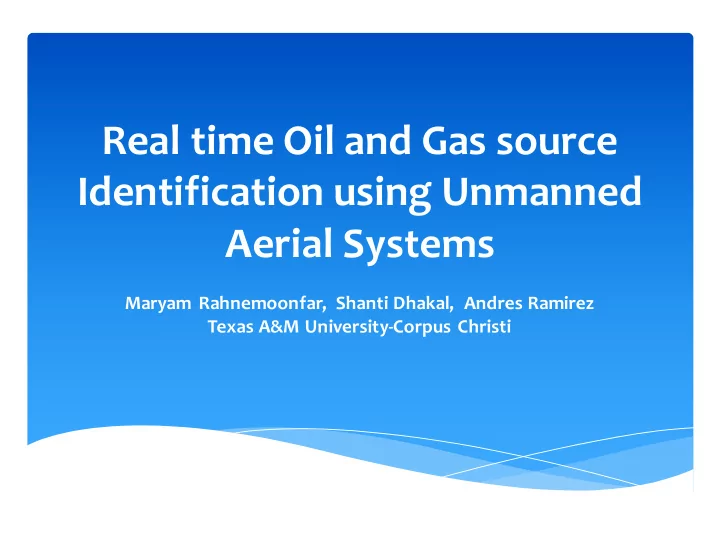

Real time Oil and Gas source Identification using Unmanned Aerial Systems Maryam Rahnemoonfar, Shanti Dhakal, Andres Ramirez Texas A&M University-Corpus Christi
Motivation ∗ Gas exploration and environmental compliance and assessment are critical activities for the energy industry. ∗ The reliability of natural gas pipelines is critical in terms of public, environmental and system safety; however, their deterioration rate is high. ∗ Annually 1,300,000 t oil enter the oceans ∗ Tanker vessel spills – 100,000 t ∗ Run-off – 140,000 t ∗ Pipeline leaks – 12,000 t ∗ Natural seepage – 600,000 t ∗ Deep Water Horizon oil spill (April 20 – July 15, 2010) 7.0 x 10 5 m 3 volume of oil spilled
∗ Satellite sensors used for preliminary oil spill assessment suffer from low spatial and temporal resolution. ∗ Time is particularly critical for an oil spill occurring in the open ocean as wind and current can rapidly spread the oil over a large area in a short time.
Oil Slick Science
∗ UAV equipped with active and passive sensors can provide detailed oil spill analysis and offer better spatial and temporal resolution than their satellite counterparts.
Spill Detection Sensors ∗ Optical Sensors ∗ Infrared ∗ Ultraviolet ∗ Laser fluorescense ∗ Microwave sensors ∗ Radar
Visible EM sensor ∗ Wavelength 400 – 700 nm ∗ Oil has higher surface reflectance than water x Sun glitter x Poor contrast x Poor discrimination between oil and background x Not operable at night/cloudy condition ü Better suited for documentation purpose ü Inexpensive and easily available
Infrared Sensors ∗ Thick oil appears hot and thinner cool ∗ At night, oil appears cooler than water x Thin sheens not detectable x Sea weed and shorelines provide false positive result ü Provide relative thickness of oil slicks ü Operable at night but contrast not as good as on daylight
Ultraviolet sensors ∗ Oil has stronger reflectivity than water ü Can detect very thin sheens (<0.1 micron) ü Inform about relative thickness of oil slicks x Cannot detect thick slicks (>10 micron) x False positive due to sun glint, wind, sea weeds x Cannot operate at night
Synthetic Aperture Radar ∗ Used extensively for remote sensing of oil spills ∗ Active sensor ∗ side-looking distance measuring systems ∗ measures the time delay between transmission and reception of a pulse
synthetic aperture (antenna) The data from multiple view of the target are processed in such a way that a longer antenna is synthesized.
Sensor Advantages Limitations o Obscured by cloud & smoke ü Images are easy to Optical understand & interpret o Limited to daylight hours ü All-weather imaging o Image interpretation is capability complicated o Complex analysis ü Day/night data acquisition o Large size images ü Sensitivity to geometric shape, surface roughness, RADAR and moisture content ü Partial penetration through soil, snow and vegetation ü Microwave bands covers several octaves
(a) (b) SAR Images Showing Black Patches Caused by (a) Oil Pollution and (b) Natural Phenomena
∗ Single polarimetric SAR ∗ Gray level features ∗ Geometric and statistical features ∗ Dual and Quad polarimetric SAR ∗ Polarimetricdecomposition parameters such as entropy (H), anisotropy (A), Mean scattering angle ( α ) provide oil-spill information
UAVSAR The UAVSAR L-band radar
Feature Extraction by Polarimetric Decomposition ∗ Polarimetric features of SAR ∗ Cloude-Pottierradar target decomposition: ∗ Cloude-Pottierdecomposition is the eigenvector-eigenvalue based target decomposition. It is based on the eigen decomposition of coherency matrix . − 1 " % [ ] = U 3 [ ] ∑ 3 [ ] U 3 [ ] T 3 0 0 λ 1 $ ' [ ] = 0 0 Σ 3 λ 2 $ ' $ ' 0 0 λ 3 $ ' # &
Feature Extraction by Polarimetric Decomposition (contd.) ∗ Entropy (H) ∗ Measure of randomness ∗ High for oil spill and low for water ∗ Anisotropy (A) ∗ Higher in oil spill region than in oil-free water
Feature Extraction by Polarimetric Decomposition (contd.) ∗ Mean Scattering angle ∗ Lower mean alpha for oil spill region ∗ Co-polar correlation coefficient ∗ Low values for oil-covered region
Feature Extraction by Polarimetric Decomposition (contd.) ∗ Degree of polarization (DoP) ∗ Lower DoP for oil covered region ∗ For oil slick, DoP ≈ 0 ∗ For oil-free surface, DoP ≈ 1
PauliRGB color-coded image |S HH - S VV ||S HV ||S HH + S VV | a) PauiRGB of image 101 b) PauliRGB of image 102, c) PauliRGB of image 103
Polarimetric decomposition of image a) entropy, b) mean alpha, c) anisotropy, d) co-polar correlation coefficient, e) degree of polarization
The red region has the highest probability of oil on water surface and the blue region has the lowest probability of oil on water surface
AVRIS Hyperspectral Cube Airborne Visible/Infrared Brine Shrimp pond Imaging Spectrometer 224 spectral channels 400 – 2500 nm spectral resolution
Data reduction ∗ Curse of dimensionality ∗ Linear Algorithms Principal Component Analysis (PCA) ∗ ∗ Inaccurate Representation of High Dimensional Data ∗ Nonlinearities are often exhibited in the data due to the effects of multipath scattering, variations in sun-canopy-sensor geometry, nonhomogeneous composition of pixels, and attenuating properties of media ∗ Non-Linear Algorithms ∗ Manifold Learning ∗ Increase in Algorithm Complexity
Summary of Challenges ∗ Large size images ( ~100 GB each) ∗ Complex analysis ( SAR, hyperspectral) ∗ Multiple Sensors- Data fusion ∗ Machine Learning ∗ Time is critical ( both for data fusion and also validation)
Thank you for your attention
Recommend
More recommend